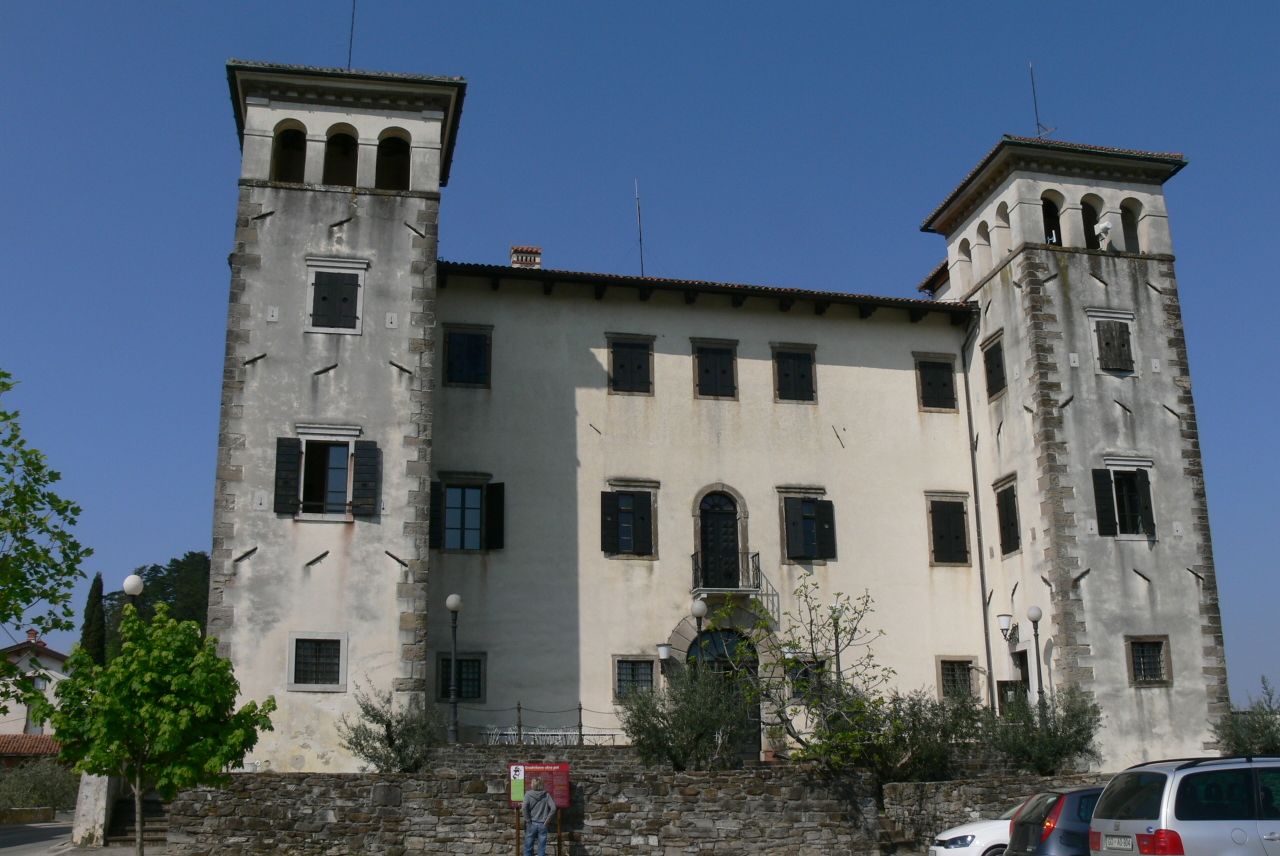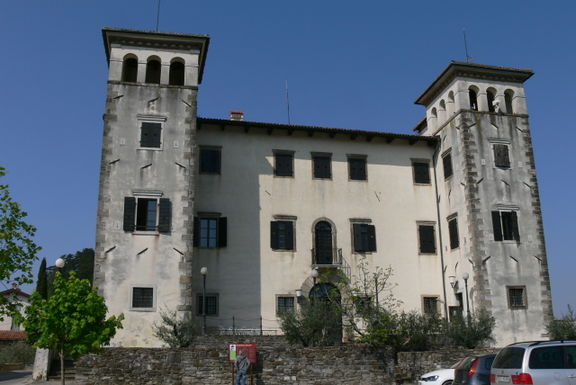Difference between revisions of "Dobrovo Castle"
(English proofreading + Updated 2020) |
|||
| (8 intermediate revisions by 5 users not shown) | |||
| Line 1: | Line 1: | ||
{{Article | {{Article | ||
| − | | status = | + | | status = NIFERTIK! PHOTO |
| maintainer = Janez Premk | | maintainer = Janez Premk | ||
}} | }} | ||
| Line 6: | Line 6: | ||
| name = Dobrovo Castle | | name = Dobrovo Castle | ||
| localname = Muzejska zbirka Grad Dobrovo | | localname = Muzejska zbirka Grad Dobrovo | ||
| − | | street = Grajska cesta | + | | street = Grajska cesta 10 |
| − | | town = SI-5212 Dobrovo | + | | town = SI-5212 Dobrovo |
| telephone = 386 (0) 5 395 9586 | | telephone = 386 (0) 5 395 9586 | ||
| fax = 386 (0) 5 335 9820 | | fax = 386 (0) 5 335 9820 | ||
| email = goriski.muzej@siol.net | | email = goriski.muzej@siol.net | ||
| − | | website = http://www.goriskimuzej.si/dobrovo | + | | website = http://www.goriskimuzej.si/stalne-zbirke/grad-dobrovo |
| managed by = Goriška Museum | | managed by = Goriška Museum | ||
| opening hours = 8am–4pm Tue–Fri, 12am–4pm and in summer 10am–8pm Sat, Sun and holiday. Closed Mon. | | opening hours = 8am–4pm Tue–Fri, 12am–4pm and in summer 10am–8pm Sat, Sun and holiday. Closed Mon. | ||
| − | | contacts = {{Contact | + | | contacts = |
| − | | name = | + | {{Contact |
| − | | role = | + | | name = Tanja Gomiršek |
| − | | email = | + | | role = Historian, Curator |
| + | | email = tanja.gomirsek@goriskimuzej.si | ||
| + | | telephone = 386 (0) 5 395 9587 | ||
}} | }} | ||
| + | {{Contact | ||
| + | | name = | ||
| + | | role = | ||
| + | | email = | ||
| + | | telephone = | ||
| + | }} | ||
| + | |accounts= | ||
| + | |||
}} | }} | ||
{{Teaser| | {{Teaser| | ||
| − | The Renaissance [[Dobrovo Castle]] was erected around 1600 on the site of an older fortification. Situated at the west side of Dobrovo settlement it overlooks Goriška Brda. In 1974 the castle was taken over by the [[Goriška Museum]] and in 1991 the Zoran Mušič Gallery was opened | + | {{Wide image|Dobrovo Castle 2011.jpg}} |
| + | |||
| + | The Renaissance [[Dobrovo Castle]] was erected around 1600 on the site of an older fortification. Situated at the west side of Dobrovo settlement, it overlooks Goriška Brda. In 1974, the castle was taken over by the [[Goriška Museum]] and, in 1991, the [[Zoran Mušič]] Gallery was opened. | ||
}} | }} | ||
== History == | == History == | ||
| − | The Colloredo Counts were the first owners, followed at the end of the 18th century by the de Catterini-Erzberg family from Gorica | + | The Colloredo Counts were the first owners, followed at the end of the 18th century by the de Catterini-Erzberg family from Gorica. The following owners were the marquises of the Montecuccoli family and in 1872 the Baguer family inherited the property. |
| − | The castle walls are believed to | + | The castle walls are believed to have been built during the Second Venetian War (1615–1617) and after the war, the walls were rearranged into a corridor with arcades. One tower was changed into a chapel dedicated to Saint Anthony from Padua. |
== Premises == | == Premises == | ||
| − | This square-shaped three-storey castle with symmetrically set four towers | + | This square-shaped three-storey castle with symmetrically set four towers was built in the style of a type of Venetian villa of the 17th century. It is surrounded by walls with two cylindrical towers. |
| − | On the ground floor there is a central entrance hall, while the first floor houses the Knights Hall | + | On the ground floor, there is a central entrance hall, while the first floor houses the Knights Hall where different musical and other events are held. Some parts of the frescos in the Hunters' Room and along the staircase have been preserved, as well as some original items of furnishing. Painted by the artist Clement Del Neri in 1894, the paintings depict the properties of the count. In front of the castle, there are remnants of a former historical park. |
| − | + | Along with the [[Goriška Museum]] branch, the castle houses a restaurant on the ground floor and a wine cellar with wines from Goriška Brda. The castle is also used for temporary exhibitions in the gallery as well as other cultural events in the castle yard. | |
== Exhibitions == | == Exhibitions == | ||
| − | The | + | The exhibitions ''Castle Collection in Dobrovo – Attempt of Reconstruction'' and ''Ad sanctos. Archaeological research at the Church of St Leonard in Dolnje Cerovo'' are on permanent display. The chapel houses a permanent exhibition of Gothic frescoes – originals and copies taken from other churches of the North Primorska region. |
| + | |||
| + | On the first floor, next to the Knights Hall, a 19th-century cultural history collection is displayed with photographs, original objects, and works of art. Also displayed there is a 17th-century fresco depicting the scene of the naval attack of the city and the coats-of-arms of former owners. Morever, a part of the collection of paintings of the last owner, Count Bagueri, is also on display in the castle. | ||
| + | |||
| − | + | == Zoran Mušič collection == | |
| − | The second floor exhibits a collection of 134 prints by world-famous artist [[Zoran Mušič]] ( | + | The second floor exhibits a collection of 134 prints by world-famous artist [[Zoran Mušič]] (1909–2005), dating from 1949 onwards. The artworks are emotionally related to Dalmatia, Istria, Karst, Umbria and the Venetian lagoon. The cycle ''We Are Not the Last'' (Nismo poslednji) is marked by the artist's experience in a Nazi camp. The collection was donated to the [[Municipality of Nova Gorica]] by the artist in 1991. |
== See also == | == See also == | ||
| Line 49: | Line 64: | ||
== External links == | == External links == | ||
| − | * [ | + | * [https://goriskimuzej.si/en/permanent-exhibitions/dobrovo-castle Dobrovo Castle web page] |
| − | |||
* [http://www.burger.si/GoriskaBrda/DobrovoENG.html Virtual guide to Dobrovo Castle] | * [http://www.burger.si/GoriskaBrda/DobrovoENG.html Virtual guide to Dobrovo Castle] | ||
* [http://en.wikipedia.org/wiki/Zoran_Mušič Zoran Mušič on Wikipedia] | * [http://en.wikipedia.org/wiki/Zoran_Mušič Zoran Mušič on Wikipedia] | ||
| + | {{Gallery}} | ||
[[Category:Monuments and sites]] | [[Category:Monuments and sites]] | ||
| Line 59: | Line 74: | ||
[[Category:Visual arts museums]] | [[Category:Visual arts museums]] | ||
[[Category:Castles]] | [[Category:Castles]] | ||
| + | [[Category:Updated 2020]] | ||
Latest revision as of 16:54, 7 September 2020
History
The Colloredo Counts were the first owners, followed at the end of the 18th century by the de Catterini-Erzberg family from Gorica. The following owners were the marquises of the Montecuccoli family and in 1872 the Baguer family inherited the property.
The castle walls are believed to have been built during the Second Venetian War (1615–1617) and after the war, the walls were rearranged into a corridor with arcades. One tower was changed into a chapel dedicated to Saint Anthony from Padua.
Premises
This square-shaped three-storey castle with symmetrically set four towers was built in the style of a type of Venetian villa of the 17th century. It is surrounded by walls with two cylindrical towers.
On the ground floor, there is a central entrance hall, while the first floor houses the Knights Hall where different musical and other events are held. Some parts of the frescos in the Hunters' Room and along the staircase have been preserved, as well as some original items of furnishing. Painted by the artist Clement Del Neri in 1894, the paintings depict the properties of the count. In front of the castle, there are remnants of a former historical park.
Along with the Goriška Museum branch, the castle houses a restaurant on the ground floor and a wine cellar with wines from Goriška Brda. The castle is also used for temporary exhibitions in the gallery as well as other cultural events in the castle yard.
Exhibitions
The exhibitions Castle Collection in Dobrovo – Attempt of Reconstruction and Ad sanctos. Archaeological research at the Church of St Leonard in Dolnje Cerovo are on permanent display. The chapel houses a permanent exhibition of Gothic frescoes – originals and copies taken from other churches of the North Primorska region.
On the first floor, next to the Knights Hall, a 19th-century cultural history collection is displayed with photographs, original objects, and works of art. Also displayed there is a 17th-century fresco depicting the scene of the naval attack of the city and the coats-of-arms of former owners. Morever, a part of the collection of paintings of the last owner, Count Bagueri, is also on display in the castle.
Zoran Mušič collection
The second floor exhibits a collection of 134 prints by world-famous artist Zoran Mušič (1909–2005), dating from 1949 onwards. The artworks are emotionally related to Dalmatia, Istria, Karst, Umbria and the Venetian lagoon. The cycle We Are Not the Last (Nismo poslednji) is marked by the artist's experience in a Nazi camp. The collection was donated to the Municipality of Nova Gorica by the artist in 1991.




